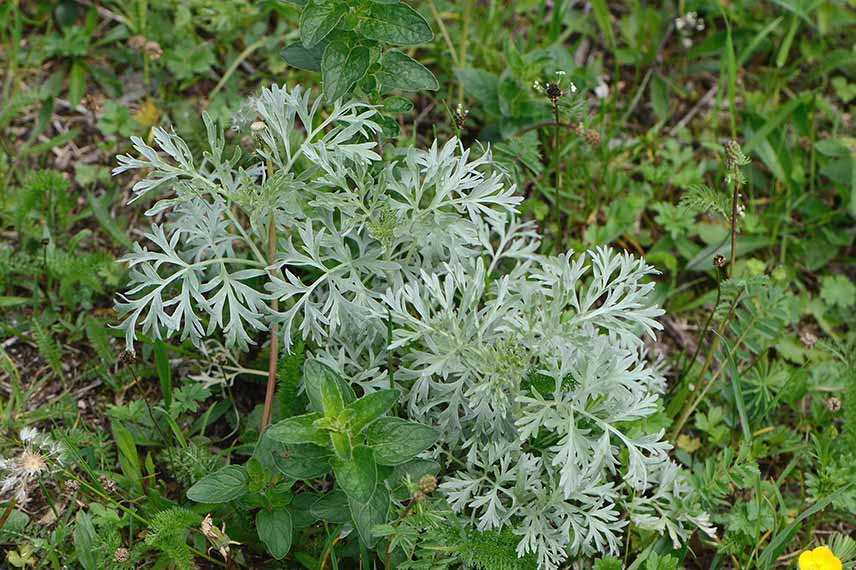It is possible to make your own wormwood (Artemisia absinthium) liquid manure, a natural fertiliser for plants and the garden. Made from the fresh plant, this liquid manure acts as a repellent against mites, slugs, snails, and insects. It is also effective against certain fungal diseases such as rust and leek moth. A powerful aromatic, wormwood is easy to grow in gardens or vegetable patches.
You can buy it ready-made, or you can try making your own wormwood liquid manure at home. Rich in thujone, wormwood is a natural insect repellent, fungicidal, and insecticidal, and once incorporated into a liquid manure, it becomes indispensable for natural gardening. Here’s the recipe for this potion, how to use it, and its benefits.
Discover how to prepare wormwood liquid manure and use it effectively, either diluted or undiluted!
Discovering Wormwood
This aromatic perennial is easy to grow in gardens. Artemisia absinthium is also known as grande absinthe, bitter wormwood, aluine, saint’s herb, maiden’s herb, or worm herb. It thrives in both sun and partial shade, adapts to all soil types, and can quickly become invasive. It develops fine silver leaves and small yellow flowers in summer. It emits a strong scent that repels insects, hence its repellent and insecticidal properties.
Required Materials
To make 10 litres of wormwood liquid manure, you will need:
- A bucket or any other non-metallic container
- Another container for filtration
- A cloth
- 1 kg of fresh wormwood
- 10 litres of non-calcareous and non-chlorinated water
- A stick
- One or two plastic containers
- A pair of gloves
- A pruning shear
- A funnel

Wormwood foliage. © Nicolas Weghaupt, Public Domain
Step-by-Step Preparation of the Liquid Manure
To make the fermented wormwood extract, follow these key steps:
1) The Recipe
For making liquid manure, it is preferable to use rainwater or non-calcareous water, as lime blocks the absorption of active ingredients. The water should also be non-chlorinated; otherwise, let it sit for 48 hours, stirring occasionally to reduce chlorine levels. For the container, opt for plastic or wood. Metal may cause oxidation and compromise the preparation.
To make approximately 10 litres of wormwood liquid manure, you will need to harvest 1 kg of fresh leaves and flowering tops for 10 litres of water.
2) Harvesting
Using pruning shears, gather fresh leaves and flowers at the start of flowering. If you don’t have fresh wormwood, you can dry it beforehand. Use about 30 grams of dried wormwood per litre of water. Weigh approximately 1 kg of leaves.
3) Preparing the Liquid Manure
Place the leaves and flowers, unchopped, in the container and add water. Cover with an old cloth to allow fermentation gases to escape and let the mixture steep for 10 days. Ensure the container is placed in a shaded spot.
4) Stirring the Liquid Manure
Use a stick to stir the mixture daily for at least 10 minutes.
5) Fermentation
Depending on the temperature, fermentation may take between 10 and 15 days. When you notice no bubbles or white foam on the surface, this indicates the fermentation is complete and the liquid manure is ready. If left too long, the mixture will rot, and you’ll have to start over.
6) Filtration
Using a sieve or an old cotton cloth, filter the mixture to remove plant residues. Any impurities could clog the spray nozzle!
7) Transferring the Liquid Manure
Once filtered, use a funnel to transfer the liquid manure into an opaque, labelled plastic bottle, sealed tightly. For safety, store it on a high shelf in a cool, ventilated room. Avoid areas exposed to heat.
Storing Wormwood Liquid Manure
Prefer an opaque plastic bottle that seals tightly to preserve the liquid manure’s properties. Store it in a dark, well-ventilated area away from heat. The liquid manure can be kept for several months until a new batch is prepared.
How to Use Wormwood Liquid Manure in the Garden
This fermented extract is highly effective in the garden for combating:
- Cabbage white butterflies, carrot flies, asparagus flies, onion flies, flea beetles, caterpillars, leek moths, aphids, ants, and codling moths, to be used as an insect repellent and insecticide;
- Slugs and snails, to be used as a repellent;
- Diseases such as currant rust, to be used as a fungicide.
Wear gloves before handling the liquid manure.
Use it in a sprayer, either undiluted or diluted, depending on the application:
- Dilute it to 10% (1 litre of liquid manure to 9 litres of water) for use against codling moths or cabbage white butterflies. Spray trees or vegetables before and during the appearance of butterflies and the hatching of caterpillars. Treat every 15 days from early June to late July and during egg-laying for cabbage whites and codling moths;
- Use it undiluted in the sprayer against flies (carrot, asparagus, onion), moths, rust, aphids, currant rust, and slugs. Repeat the spray 10 days later if necessary, until the pests disappear. As with all plant extracts, use them sparingly!
Apply these sprays in the evening or morning, preferably during dry weather. Avoid spraying on sunny days to prevent plant burns.
To complement your homemade liquid manures, read our guide on nettles and their many benefits, and explore our tutorials: How to Make Nettle Liquid Manure, How to Make Fern Liquid Manure, How to Make Comfrey Liquid Manure, and How to Make Horsetail Liquid Manure.
Discover other wormwoods like Artemisia vulgaris and valuable tips for growing them in this article: Planting, Pruning, and Caring for Wormwood.
































Comments